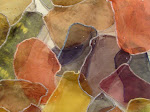.jpg) The Clouded Principle (Mrs Evelyn D. Bing, 1974)
The Clouded Principle (Mrs Evelyn D. Bing, 1974)Tom Davie
The images of your childhood are most likely fond and frosted, filled with adventure and excitement, the wildness and freedom of late night games, and endless conversations of all of the new discoveries of the day. Looking back, the events seem to present themselves as pictures, small snap shots of people and places. One of the places in my childhood was the Church. My experience with the Church may be different then most, as it was actually very positive, but still filled with quite a few interesting individuals. The concept of returning to this time in ones life is very common, however, utilizing the directory of your childhood church from the year you were conceived is very unique. Yet that is exactly what Ohio resident Tom Davie is utilizing in his latest series of paintings.
With each detail painted by hand, these paintings aren't simply faces from his youth, but a representation of his fondness for the time and the conflicted journey since. It was this journey that led Tom to the School of the Art Institute of Chicago where he received a masters in fine art in visual communication. Since that time Tom has been able to work as a designer, educator, and artist.
Recently, Tom took some time out to answer a few of my questions.
Orange Alert (OA): How would you describe your style of painting?
Tom Davie (TD): For lack of a better term, I would describe my painting style as screen-print inspired. After spending years working with offset lithography and print production as a graphic designer, I decided to adapt my knowledge of commercial production and printing into fine art.
Most of my sketches and final layouts are created using Adobe Illustrator and Photoshop. The process I use to make the paintings is similar to that of screen-printing. A laser printer is used to generate color separations, and I carefully mix pigments to closely replicate colors from the computer files. However, instead of using a screen to produce the work, I draw the imagery directly onto canvas and paint it by hand. I like to create work that can be generated as a digital print, screen-print or painting. This gives me a lot of flexibility with interchanging different mediums, while being able to retain a consistent theme or concept for the art.
.jpg) Collective Parishioner, 3 (Mr. Arthur A. McCall, 1974)
Collective Parishioner, 3 (Mr. Arthur A. McCall, 1974)OA: Your latest series of paintings focuses on “personal struggles concerning faith in God, the Catholic Church, and impending mortality”. Each piece has a very specific title followed by a persons name and a date. Are these actual images from your childhood? What was it about that time in your life that inspired this incredible series?
TD: The images used in this series all come from a single source, the 1974 parishioner directory from my childhood church. The directory has the feel of a high school yearbook, in that every page contains rows of family portraits, which are individually labeled with the names of family members. The portraits are really engaging, partly due to the inconsistency with which the families were photographed. In some cases children are in front of adults, in others they are not, some people are alone; some are really close to the camera, while others are much further away, some are young families, and others are elderly and at the ends of their life. Many of the people have genuine smiles, while a few have forced expressions or no expression at all. The entire book just seems very authentic to me, in both depicting a small midwestern town and representing those with similar religious convictions.
The 1974 directory was chosen as the basis for my painting series because it was the year I was conceived. I liked the concept of using the 1974 directory because it questions the Christian notion of when a person’s soul is created. If the soul exists at the point of conception, then I was a member of this religious community in 1974, not 1975 — the year I was actually born into it.
I explored this period in time, because for me, childhood represents purity, trust and belief. As an adult, you are sometimes forced to embrace or question certain fundamental childhood beliefs. In this case, I have been struggling to determine whether I share my parents’ ideals when it comes to religion. These paintings represent my journey of guilt, confusion and uncertainty, and oftentimes, I wish I could go back to those earlier years, where I had the unquestioning faith of a child.
The 1974 directory was chosen as the basis for my painting series because it was the year I was conceived. I liked the concept of using the 1974 directory because it questions the Christian notion of when a person’s soul is created. If the soul exists at the point of conception, then I was a member of this religious community in 1974, not 1975 — the year I was actually born into it.
I explored this period in time, because for me, childhood represents purity, trust and belief. As an adult, you are sometimes forced to embrace or question certain fundamental childhood beliefs. In this case, I have been struggling to determine whether I share my parents’ ideals when it comes to religion. These paintings represent my journey of guilt, confusion and uncertainty, and oftentimes, I wish I could go back to those earlier years, where I had the unquestioning faith of a child.
OA: I am fascinated by the look of these pieces, and I’ve read they are all painted by hand. How is that effect achieved? What is the starting point for a typical piece? What are a few of the verses that the viewer might find in the pieces?
TD: Each painting from this series starts on the computer. The imagery is scanned and layered using Adobe Photoshop – in some cases, allowing information from ten or more individuals to be incorporated into a single painting. Once the composite image is created, and the highlights and shadows have been adjusted for contrast, the file is printed and drawn onto canvas. Using the drawing as a guide, the canvas is meticulously painted by hand. In instances where text appears, I create the words by applying them in varnish directly onto the portrait.
All of the text included in this series is taken from Biblical passages. For example, the painting titled, Bound To Afflict (Mrs. Esther R. Andres, 1974) uses text from Judges chapter 16 verse 6. The entire verse reads, “And Delilah said to Samson, Tell me, I pray thee, wherein thy great strength lieth, and wherewith thou mightest be bound to afflict thee.” With the verse chosen, I select a portion of it to include on the painting. The final text reads, “Wherein thy great strength lieth, and wherewith thou mightest be bound to afflict thee”, and “Bound To Afflict” becomes the title. I like to use the Book of Revelation a lot, as the text is dense and ominous, and seems to work well with the visual aspect of the paintings.
TD: Each painting from this series starts on the computer. The imagery is scanned and layered using Adobe Photoshop – in some cases, allowing information from ten or more individuals to be incorporated into a single painting. Once the composite image is created, and the highlights and shadows have been adjusted for contrast, the file is printed and drawn onto canvas. Using the drawing as a guide, the canvas is meticulously painted by hand. In instances where text appears, I create the words by applying them in varnish directly onto the portrait.
All of the text included in this series is taken from Biblical passages. For example, the painting titled, Bound To Afflict (Mrs. Esther R. Andres, 1974) uses text from Judges chapter 16 verse 6. The entire verse reads, “And Delilah said to Samson, Tell me, I pray thee, wherein thy great strength lieth, and wherewith thou mightest be bound to afflict thee.” With the verse chosen, I select a portion of it to include on the painting. The final text reads, “Wherein thy great strength lieth, and wherewith thou mightest be bound to afflict thee”, and “Bound To Afflict” becomes the title. I like to use the Book of Revelation a lot, as the text is dense and ominous, and seems to work well with the visual aspect of the paintings.

OA: I also really enjoy the “Bottled Food” series, what was the motivation behind this series?
TD: The bottled food series was created after seeing commercials for Campbell’s® Soup at Hand® — soup that is meant to be eaten directly from its container. The ads got me thinking about convenience and laziness; as a society, has it come to the point where even making a cup of soup is so complex that we need an easier alternative? I also began to think about traditional packaging and what, as a consumer, I expect certain packages to look like.
This series is not an attack on consumerism or the companies represented; in fact, I find these products interesting. The bottles are meant to get the viewer to engage with everyday products, and view them in a different manner than they might in a grocery store setting.
The bottle labels are made directly from the original purchased products. There has been no photo manipulation. The original packages were simply cut out and rearranged to work on the bottle format.
Sadly, these photographs are all that remain of the original food product bottles as some of the food does not age well over a significant period of time. Let me just say that Trix with milk and potted meat really start to get funky after about the third week.
TD: The bottled food series was created after seeing commercials for Campbell’s® Soup at Hand® — soup that is meant to be eaten directly from its container. The ads got me thinking about convenience and laziness; as a society, has it come to the point where even making a cup of soup is so complex that we need an easier alternative? I also began to think about traditional packaging and what, as a consumer, I expect certain packages to look like.
This series is not an attack on consumerism or the companies represented; in fact, I find these products interesting. The bottles are meant to get the viewer to engage with everyday products, and view them in a different manner than they might in a grocery store setting.
The bottle labels are made directly from the original purchased products. There has been no photo manipulation. The original packages were simply cut out and rearranged to work on the bottle format.
Sadly, these photographs are all that remain of the original food product bottles as some of the food does not age well over a significant period of time. Let me just say that Trix with milk and potted meat really start to get funky after about the third week.
OA: What were you able to take away from your time in Chicago, and more specifically your time at SAIC?
TD: Chicago is a great city with a strong art scene, I really enjoyed my two years living in the South Loop.
SAIC was a life changer for me. It was the first time I was really exposed to so many talented artists working in tons of different mediums. I spent a lot of time working in the printmaking department, took tons of art history classes and was constantly getting feedback from faculty in many different disciplines. The strange thing is that I never took a painting class at SAIC, although a majority of what I was producing, especially in my second year, was on canvas. I really wanted my paintings to be free of rules and restrictions, so I avoided structured classroom settings. From a technical standpoint, everything I have learned has been through personal trial and error.
OA: What’s next for Tom Davie?
TD: In the next few weeks, I am giving a lecture at the Dayton Art Institute museum, doing an interview on NPR in Ohio – which will focus on my paintings and thoughts on faith and religion, and have quite a bit of work in the soon-to-be-released book, Almanac of Asia-Pacific Design III — being published out of China.
As far as new work goes, I have started on a group of paintings that I’m keeping under wraps for the time being, but the concept of this series deals with encoded messages. Be on the lookout, because I might reveal a few of the new paintings on my blog or website in the near future.

Bonus Questions:
OA: Coffee? If yes, what is your favorite type of coffee and where is your favorite coffee spot?
TD: Sorry, but no coffee for me. I have the same relationship with coffee that I do with Tequila — I will avoid them both just long enough to forget my dislike, but will periodically give them another chance, only to be left with the same (but different) day-after regrets. It’s a vicious cycle, I know, so now, the closest I get to coffee is Swiss Miss hot chocolate, which is like a taste of the Alps in every cup. Actually, instead of caffeine, I prefer a sugar fix — I usually start the day with a heaping helping of Apple Jacks or Franken Berry cereals, what can I say, I love the kids stuff.
OA: Coffee? If yes, what is your favorite type of coffee and where is your favorite coffee spot?
TD: Sorry, but no coffee for me. I have the same relationship with coffee that I do with Tequila — I will avoid them both just long enough to forget my dislike, but will periodically give them another chance, only to be left with the same (but different) day-after regrets. It’s a vicious cycle, I know, so now, the closest I get to coffee is Swiss Miss hot chocolate, which is like a taste of the Alps in every cup. Actually, instead of caffeine, I prefer a sugar fix — I usually start the day with a heaping helping of Apple Jacks or Franken Berry cereals, what can I say, I love the kids stuff.
OA: Do you listen music while painting? Who are some of your favorite musicians to listen to while painting and in general?
TD: I constantly listen to music while I work. My favorites in no particular order are: Radiohead, Air, Bill Withers, Curtis Mayfield, Zero 7, Fiona Apple, Portishead, B.B. King, Slick Rick, Parliament / George Clinton, Led Zeppelin, The Beastie Boys, Beethoven, Marvin Gaye, Edan, Pink Floyd, Sneaker Pimps (but only the Becoming X album), and pretty much all 80’s pop.
For more information on Tom Davie please visit his website.
+by+Nick+Volkert).jpg)





















No comments:
Post a Comment